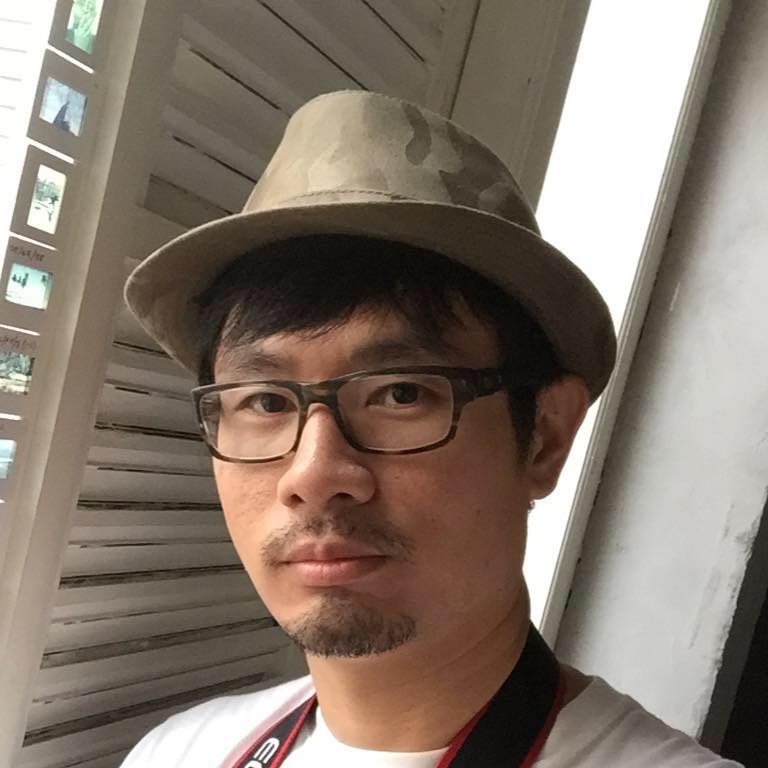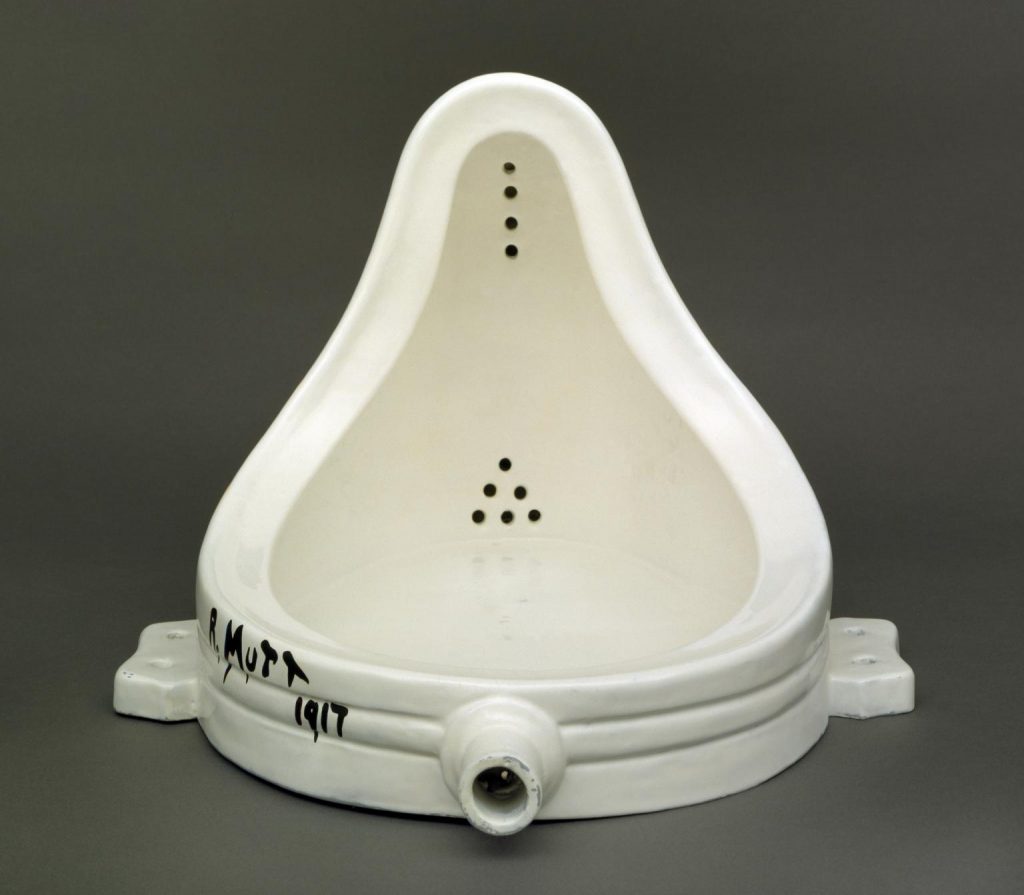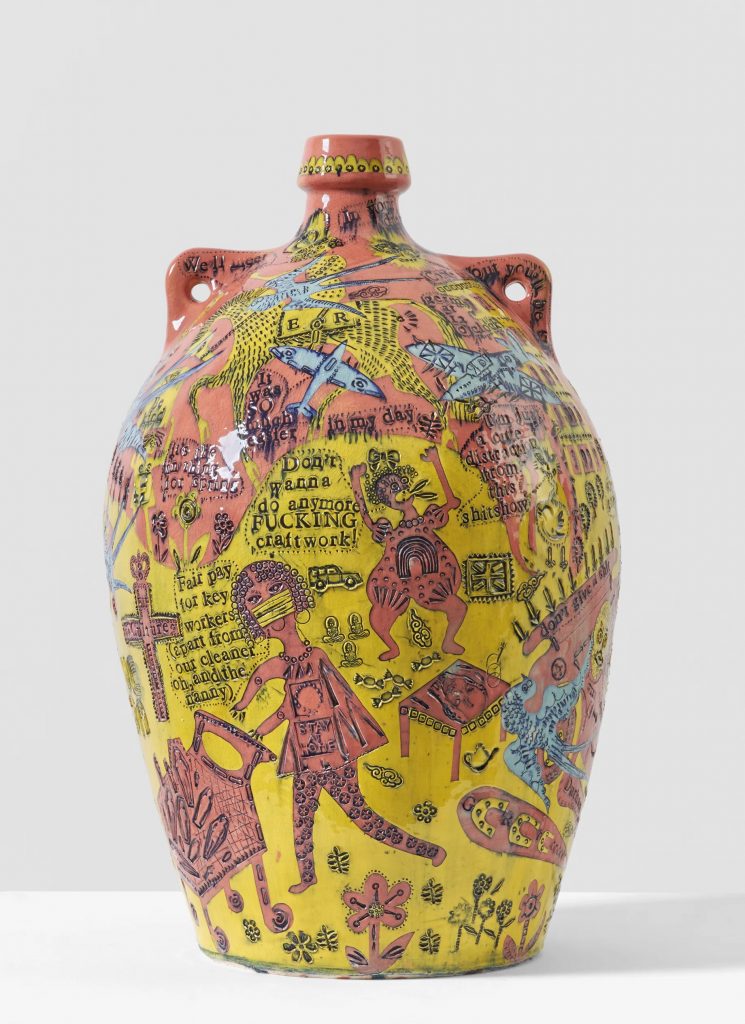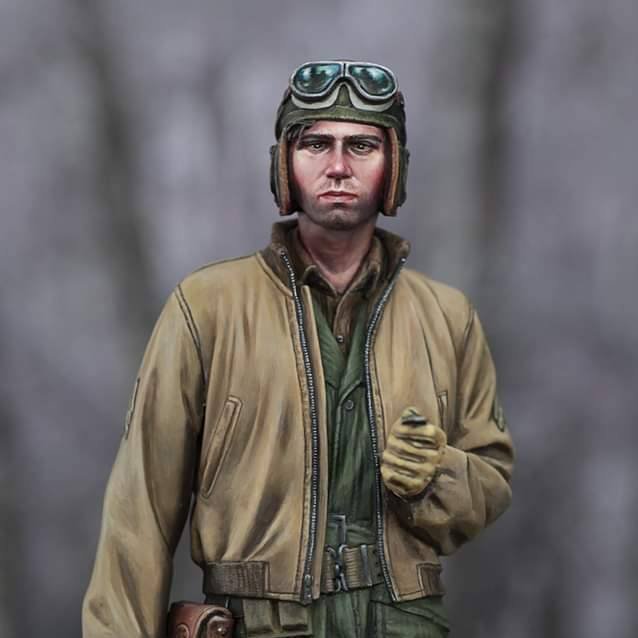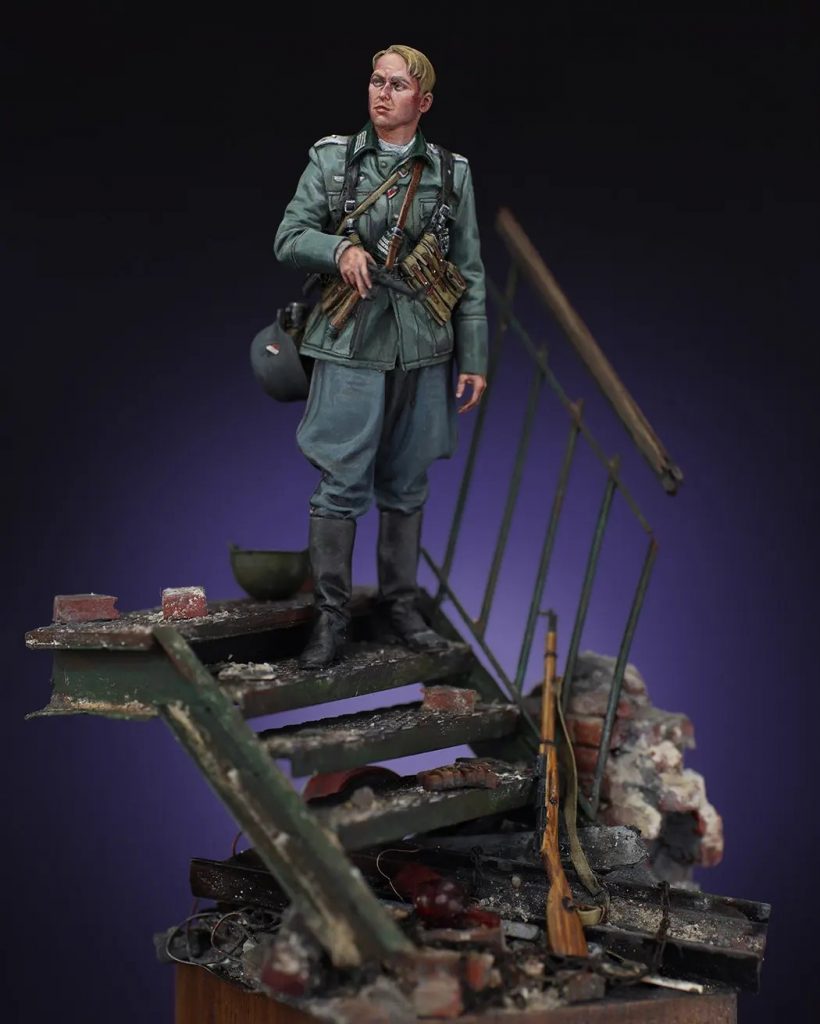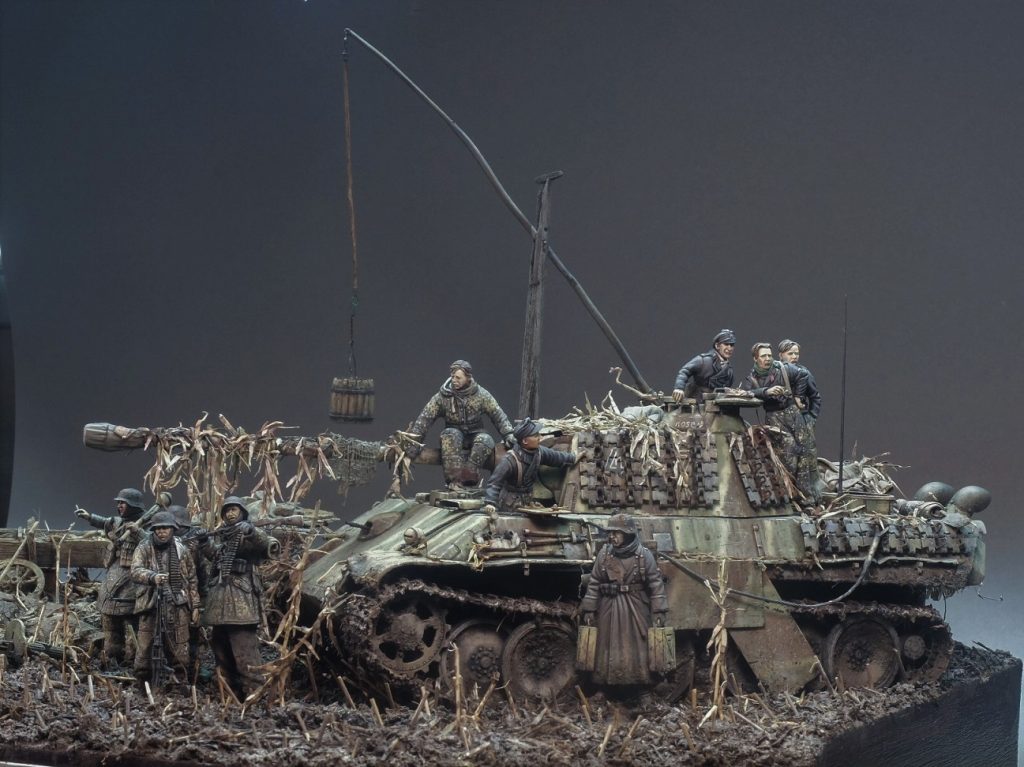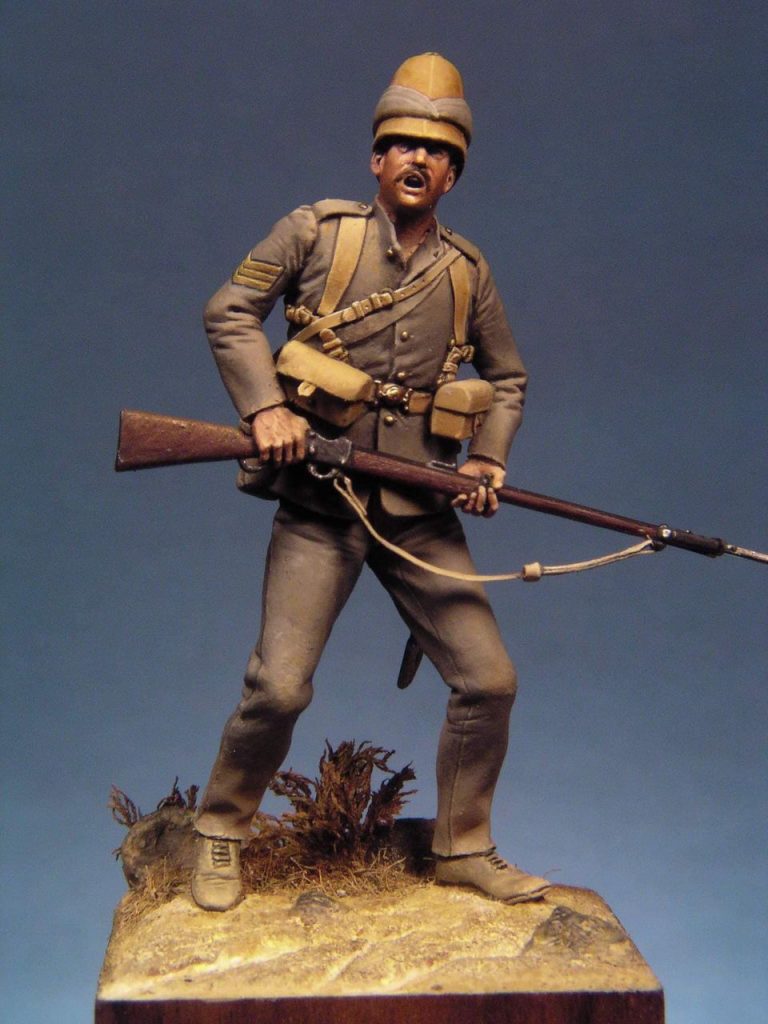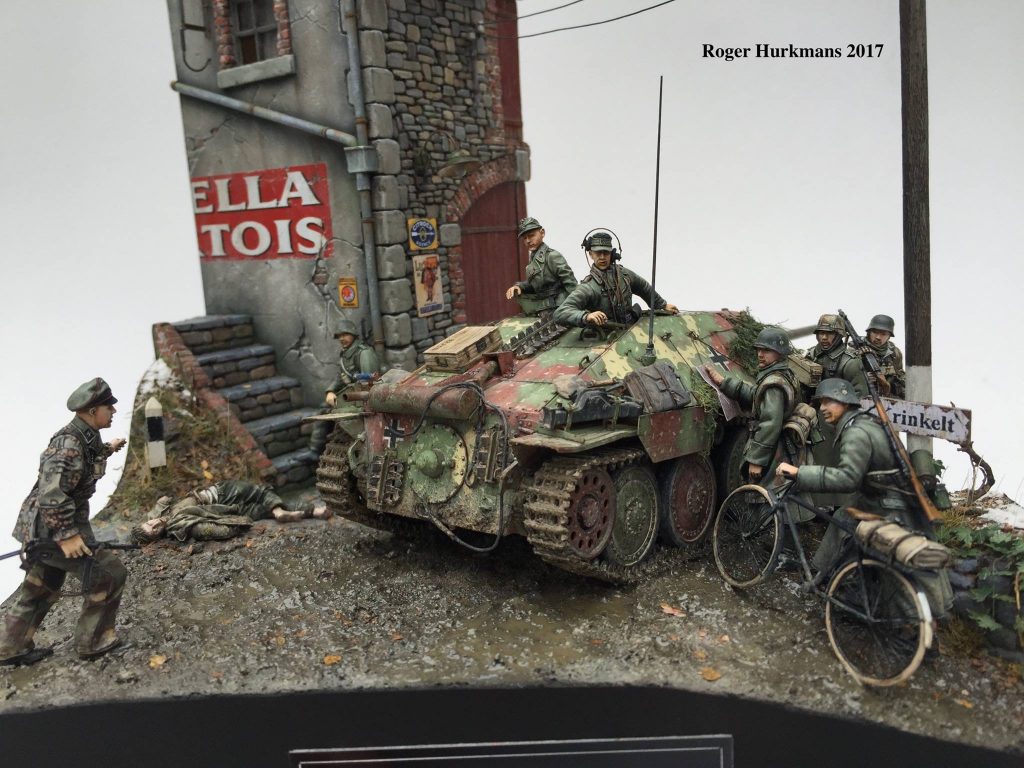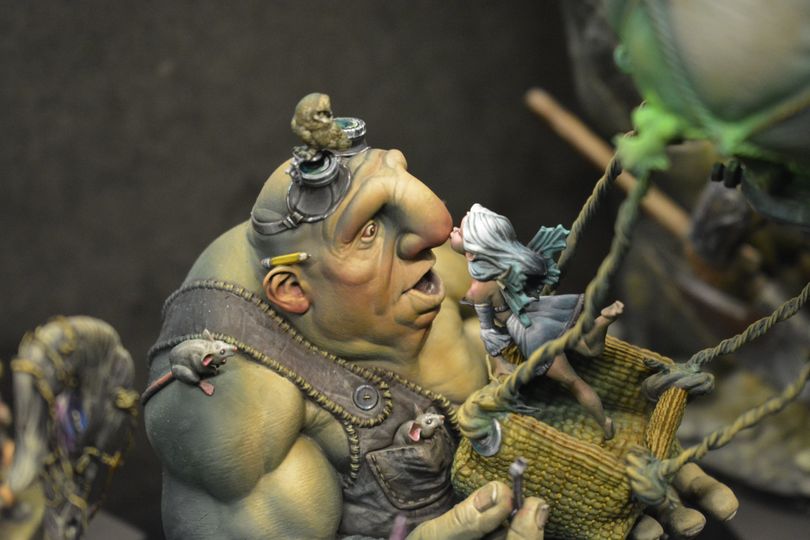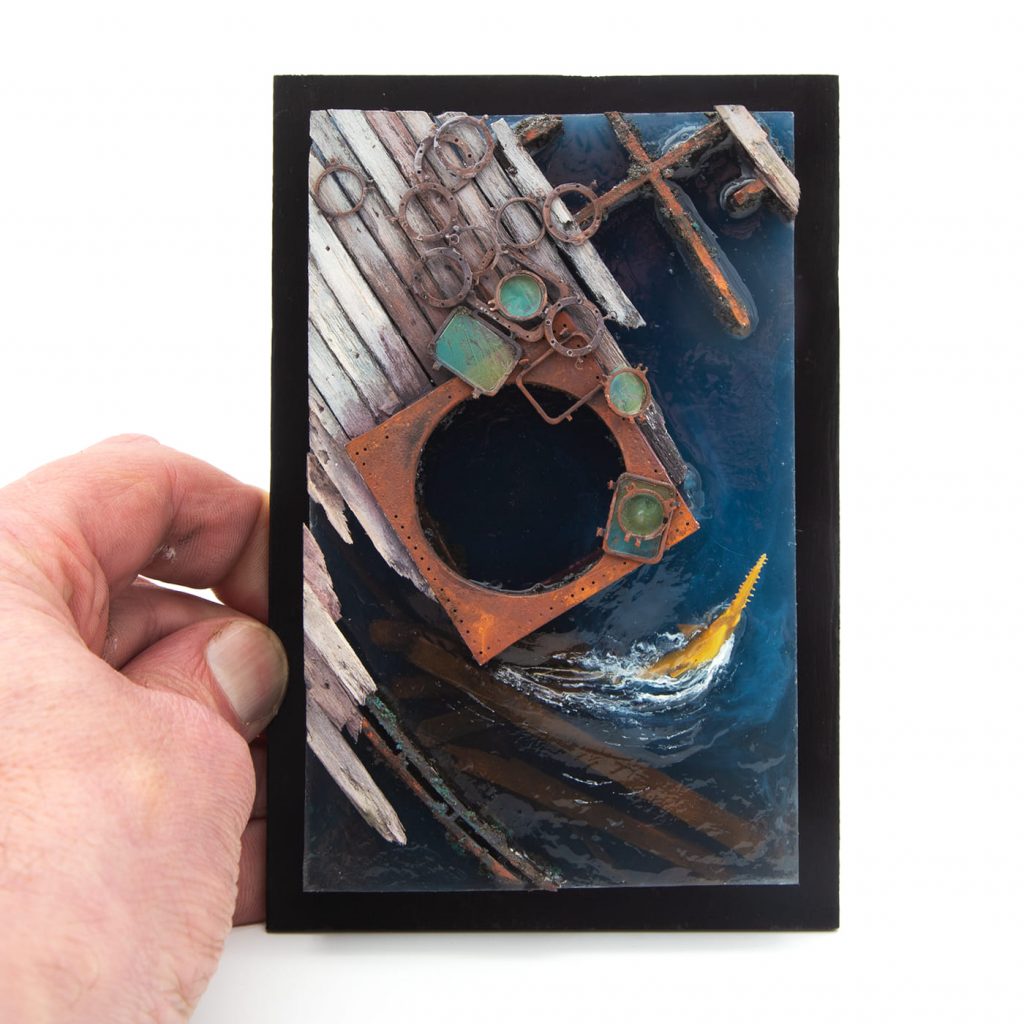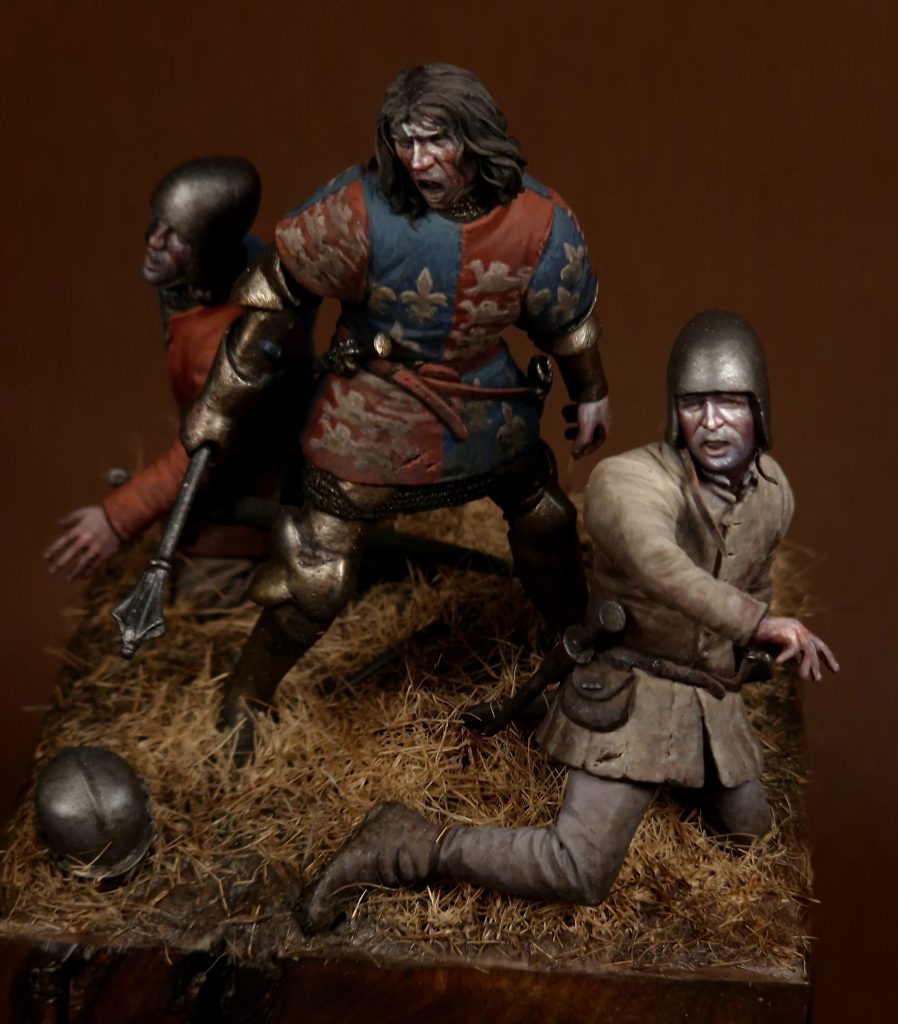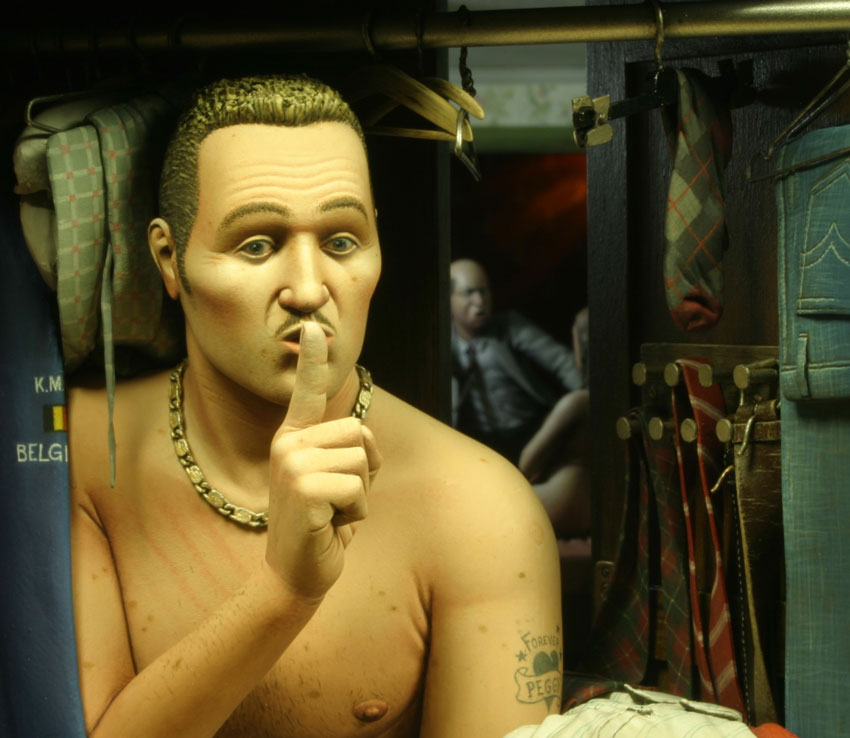
In the last blog, I talked to Jean Andre about colour, and our conversation mostly concerned colour in dioramas, and due to my own background perhaps: scale models. During that conversation, Jean and I touched on figures, but I thought it would be really good to talk to a figure modeller about colour to round out the conversation.
The painter I chose, is Tue Kaae. Tue is someone I met last year at Scale Model Challenge, when he took part in the figure painting panel discussion Tracy and I recorded for the Sprue Cutters Union Podcast. I was really impressed by how deeply Tue thinks about what he does, and how articulate he is in discussing it, and that’s exactly the kind of creator I want to bring you for this podcast and blog.

Before I get on to the interview, I just want to remind you that the Model Philosopher is sponsored by the world’s leading hobby show, the most exciting event in the model calendar for figure modellers, armour modellers, diorama modellers, aircraft modellers, ship modellers and every other kind of modeller: Scale Model Challenge.

Scale Model Challenge is not just a show, it’s a full rich event that celebrates the hobby and craft of modelling with a world class competition with over 3000 entries each year, where everyone from beginners to the leading modellers in the hobby, come to show their work to their peers. They have a program of 14 workshops from leading modellers and painters, including Gerard Boom, Eric Swinson, and Jean Bernard André where you don’t just get to hear what they do, you get to work on a project with their instruction and personal guidance. There are over 150 unique vendors selling everything from kits, to limited edition figures, to tools, to aftermarket, to diorama accessories and everything else you might need for your own miniature masterpiece, and all in a phenomenal conference venue easy to reach by air, road or rail with the world famous (in modelling circles) abbey bar.
It’s the show you should never miss. Scale Model Challenge. Check out the details at www.scalemodelchallenge.com or look up scale model challenge on the socials

OK back to our interview. Lets dive in and hear from Tue:
Chris
welcome to the Model Philosopher to Tue Kaae. Thank you for joining us
Tue
I’m happy to be here. I’m very, very happy for the opportunity. You’re supplying a reach to an audience that I don’t normally have a chance to talk to. So I’m super happy to be here.
Chris
Well, I’m hoping modelists of all kinds, for want of a better word, are going to get something out of this podcast. It’s not quite as subject driven as the Spruecutters Union podcast that I did, in terms of being aimed more at modelers, rather than figure painters or something else.
It’s more about the concepts. And I think the concepts can be universal. But that being said, I hope people have listened to the last episode (or read the previous blog) where I spoke to Jean -Andre about colour and he spoke from a diorama point of view. But I was very conscious, while we were talking, that we had a kind of a bias in favour of dioramas and models. And given that colour is something which I think is far more developed in figure modelling and figure painting circles.
I wanted to get someone on to talk from that point of view. The first time I remember seeing your work was very recently, because I’m a bit late to the party, at World Model Expo. And I was really struck by the use of colour you did there. So I got in touch and we decided to get you on and talk from your point of view.
Tue
So, with military modelling, is that the right word? Yeah, historical modelling. I think the base premise, the sort of the merit that everyone has agreed that is to be achieved is about correctness. It’s about getting the right colour.
Chris
Hmm. I guess so, yeah.
Tue
It’s about, I mean, “museum grade” is like a really high praise. So everything is about getting things right. Where the base mindset in my end of the fantasy painting is to get things exciting.
So, the whole idea about what we as a community have decided is merits to be achieved. They’re just very different. They’re not better or worse, but it’s just a very different mindset. I don’t care if the orc is green or red or brown or whatever, as long as it looks cool.
Chris
I did chuckle slightly there, the reason for that is when people say “it’s museum quality”. Most of the models I’ve seen in museums are pretty awful. So it always makes me laugh when people say that like it’s a good thing. But it is, I mean, it’s a phrase which people take, you know, to have a meaning, which is that it’s good.
Now, with colour accuracy, this is something I came across, in particularly in aircraft modelling, because I used to edit Scale Aircraft Modelling magazine for Guideline Publications. And there was a lot of talk about scale colour accuracy, to the point where it was important to the exclusion of everything else. And I think that is very the idea of accuracy and realism, in air quote marks, because realism to me is a subjective, value judgment. It’s not an objective truth because how realism observed changes person to person.
But anyway, caveats aside, I’m getting diverted already. I think it’s something that is changing. Certainly, from my own point of view, I’m not so interested in colour accuracy anymore in military modelling. I’m more interested in telling the truth by which I mean sort of the emotional truth and the story truth that I am with making the model completely accurate.
Tue
So many people think that accuracy is truth, and they might be right, but I think it’s a very, very boring version of it. mean, all the history, all the story that we get told is subjective as stories told by the victor.
Chris
don’t get me started on that. don’t believe in that phrase. It drives me mad. I think that’s something people say, but it’s not actually always true. If it was, then we wouldn’t have the Confederate “lost cause” thing and we wouldn’t have neo -Nazis telling us that, you know, the Germans were far more powerful than they actually were, and things like that. to a certain extent, yes, but also no. But anyway, we’re going to get distracted again.
This is gonna be one of those conversations where we constantly go off all over the place. But for me, the way it works is a fact is something which is observably so, from various different points of view. So, a fact is something that people can agree on is a fact is a thing. A truth is an opinion that you form of the fact based on the fact. So a truth is something that feels right to you, but isn’t necessarily shared by everyone else.
Everyone can have kind of their own idea of what’s truth, but facts are facts, if you see what I mean. So one’s subjective, which is truth, and the other’s objective, which is facts. But that’s, basically semantics, and this isn’t really an English semantics podcast. So I don’t really want to get into that.
Tue
But I find language fascinating and interesting. And to me, fact and truth are the same.
Chris
To most people they are. Perhaps I separate them just because it suits me for my argument, who knows? But you did say something else there, which was more important and something we should get back to. Remind me, what did you say about colour in fantasy?
Tue
Hahaha
So, the fantasy painting community is sort of splitting at the moment, kind of similar to the way that fantasy broke off from historical, like 20 years, 30 years ago. There’s two different main directions that fantasy painters go into.
I’m clearly and firmly in the fantasy miniature art direction, and I want to do less and less trope stuff, less and less fantasy stuff. And there’s a faction that is led by Games Workshop and Golden Demon and that whole crowd. And that one is actually, by now, relatively close to the old school historical stuff. So, you are starting to get Warhammer rivet counters. Like people who put down your paint job because you put the wrong logo on the knee pad of the spacer. And then it doesn’t matter how well you paint it because you made a mistake and that is not the way that it’s supposed to be.
Chris
Well, when they created the lore and there’s hundreds of books now, I know I’ve been reading some of them, they’re quite good, some of them. But when they created that, they created a history basically for their fantasy universe. And it’s an incredibly detailed history, which has mostly a strong continuity to it, you know, a strong canon. So essentially, it’s historical modelling, just the history’s made up.
Tue
Yep, yep, it is.
Chris
but it has the same restriction, like you say, doesn’t it? That if you want to paint an ultramarine, you should use Macragge blue, because that’s the correct blue for an ultramarine. And any other blue is incorrect and stuff. And so you get these restrictions they’ve created for themselves.
Tue
Yeah. And they did that because it’s a company and they want a coherent marketing. want you to instantly see that it’s a Games Workshop miniature. They have all kinds of motivations about that. But it means that it spills down into the miniature painting as well. So personally, I would much rather see a brown or red orc because it’s more interesting. I mean, green can be interesting well, but in that other direction, orcs need to be green.
So I’m speaking very much from my side of that fence. I think we’ll get a stronger and stronger division between the two. Not that the relation between the two groups will be divisive, but there’s a definite, just different currents, whereas some people want a much more miniature art and emotive and artistic prostrate.
So I think the majority of people prefer the like escapism world building thing.
Chris
It may surprise you, but a similar kind of thing is happening in scale modelling and history modelling as well. That there are some people, mostly diorama makers that want to do something artistic and emotive and it tells a story. Even if the story is based on history, want to, the story is more important than the colours and so on. But most people want to make an accurate thing based on the rules.
and so on. So I think in a way it’s kind of similar. Is it really interesting that fantasy’s done that though? Because it didn’t need to do it, if you see what I mean. Because you’re starting out from something created, something imagined, you would think maybe it’s just something about people. Some people like rules, some people don’t like rules.
Tue
Yeah, yeah. I think so. I think so. I’m very, very happy to hear that it’s happening in the historical community. I had a feeling that it was. I think that the whole… I’m gonna rant now. Are you ready?
Chris
Yeah, go for it. We love rants.
Tue
So I think that there’s a lot of gatekeeping in the historical community. We’re getting quite a bit in the fantasy one as well, most of the sort of base infrastructure in historical is made around “if you don’t do things the way that Shepard Paine would have done, you’re doing it wrong.” You can modernize some of the techniques, but there’s some very, very set in stone merits that you have to stick to. And if you’re painting your tank pink, the first question [is not] “that’s interesting. Why did you do that?”, The first interaction is “you did it wrong”. And I think it’s a really, really unhealthy way to build communities. And it’s a very common way to build communities. And I think that fantasy, at least my side of the fantasy, are way better at that. And having that much more free mindset about what you can do, it’s much more how you can interpret the stuff in an interesting way. It definitely started with the diorama Builders, just as you’re saying, but there’s a definite pull in the opposite direction.
The problem is that there’s a lot of money in it now as well. And especially at competitions, it’s very, very clear that there’s a lot of money in it and money is steered by consumers, and consumers have no taste and no taste for something new and something different. They basically just want whatever they’ve been told the past years that they should want. It’s why pop music is forever there.

Chris
I think it’s kind of true, but I also think that people don’t know what they want until they see it. And until they see it, they think they want what they can already get. So I think you need risk takers to show them something new, but the risk is you won’t make any money. And as long as its money involved, people are risk-averse.
Tue
Mmm, yep. I agree.
Yeah, I’m extremely privileged that I can spend a lot of hours doing the things that I do and I don’t need to sell them. The problem is that most of the people who paint to a very high degree, they do that for a living and they need to sell whatever they’re making. So they’re tied to the money. They can’t just take out two months and do their own thing because so many of them either are already professionals
We have a lot of professionals now, or they wanna be professionals and then they need to follow the current. So I’m doing something that is very different than most other people and I’m privileged enough to be able to do that. I mean, generally I don’t sell my pieces. I sold two pieces, I think, and those were relatively random. Because I spend a lot of time, I’m not mainstream.
I don’t have a large social media presence. I don’t have the things that you need to have in order to make a lot of money on it. I just do these things. Don’t even really do them for myself that much. I do them in order to show people a different way. I’m the risk taker and I think challenging the standards is way more interesting than doing something that everyone agrees look pretty.
Chris
Well, see, this is something that I could do a whole episode about. think at some point in the future we need to, because I should tell you there’s no money in the historical modelling side, maybe in the historical miniature side, but not in the historical modelling side. No one pays anyone to do anything. There’s no money in it at all. And yet they still put restrictions on themselves.
Tue
They do seem to.
Chris
Anyway, colour plays a big role in your work, which is why I asked you on. So where do you get your inspiration for colour from? Is it from arts? Is it from nature? What has the biggest influence on you in colour?
Tue
It’s definitely not miniatures, but it’s a very, very wide ranging thing. I get a lot of inspiration from mostly digital painting. I think there’s a lot of inspiration in oil paintings and the old stuff. I generally want more contrast than you get in the old stuff. mean, Rembrandt paints fantastic portraits, but there’s not a lot of colour in it.
And you can develop a palette that is very harmonious, like Rembrandt, and get wonderful things out of it. But you’re choosing not to use the colour contrast as a tool in your arsenal. And I would rather use all the tools that I have access to. So I get a lot of inspiration from like 10, 15 different 2D illustrators.
That’s mostly where things come from. I mean, almost all of my stuff is I see some little doodle or a half an illustration. And then I think I remember how it looks. And when I look at it again, it doesn’t look anything like I thought it did, but I’m just running with that idea. But mostly I get my inspiration from illustrators. I do quite a lot
So I would call them love letters to artists, not fan art as such, because fan art most of the time is 3D versions of 2D artwork. And I’d much rather play with their style and their palette and do love letters to their style instead of doing copies of their work. So do that a lot and study the way that they use colours.
Chris
I don’t know if you listened to the first episode with Calvin Tan, but we said in that the art is a conversation. That, you know, that when you do something, you’re starting, you’re opening a conversation and you’re inviting the viewer to respond to it with their own thoughts and so on. It sounds to me like what you’re doing is having a conversation with the artist. They’re saying something and you’re responding to that, if you see what I mean, in the same language.
Tue
Yeah, yeah, definitely. And I wanna have the conversation with the viewer of my stuff as well.
I use colour a lot, but I use colour as my premium tool to steer attention. So, contrast is very, very important. But if you’re just using contrast for contrast’s sake, it’s kind of pointless to me. To me, it’s all about the narrative. It’s all about the story, the person, and you’re using all the different things: matte and gloss, dark and light, saturated and desaturated. All those things are tools that you use in order to push the narrative. But I do use colour a lot for that.
I think a lot of people think that more saturation and more colour, this is especially true in the fantasy side of things. A lot of people just think that more is better. But it means that you get miniatures where everything is taken to a hundred percent saturation and all the different colours are fighting each other and then it’s just really busy and really messy and there’s no calm spots. You need stuff that that grabs attention and have lots of contrast either value or saturation and you need areas that are more dull. The dull areas I would argue is actually more important than the bright ones because they’re the ones that set it
You can’t really have light if you don’t have dark. If you just have more light, then it’s just a wash.

Chris
I think of it when I’m editing the sound on this, or if you look at the waveform of music, good music has some high end, some mid end and some bottom end. And if you, there’s no bottom end, it sounds tinny and there’s no sort of driving power to it. If you take the top end off, it sounds murky, muddy and there’s no sort of sharpness to the music at all. It’s very sort of flat. And it’s the same, I think with light and colour, you need all three. I’ve said it before about colour, about being muddy, you know, with everything in the mid range and not enough in the top and the bottom. But I think if you don’t have it balanced, not just light as well, but as you’re saying with contrast, areas of low contrast and areas of very high contrast and so on. If there isn’t balance to it, then it never works really.
Tue
Yeah, I use framing a lot as well. And I use colours for framing.
Chris
Can you tell us what you mean by framing?
Tue
So framing is colour placement. To me, everything is about focus management. It’s about getting the viewer to look at the stuff that you want them to look at. My similar piece about that is my space camel walking library, the one with orange backdrop where I pulled out all the boats. There’s a lot of that miniature that is very rough because there’s a lot of areas that are really fine around the rider. And if you have a fine and defined section, the eye naturally goes towards that. So you can do it with colour, can do it with value, and you can do it with detailing and all kinds of different things.
So I’m using framing for that miniature, for instance. There’s a few metallic parts. The metallic parts are chrome. So it’s the Molotov Chrome. They’re really, really, really shiny. But they’re all arranged in a circle around the main focus. So I’m the focus with these metallic bits. If you have a miniature and like if you have a figure in an A pose. Then you do light on the hands and light on the face, but the face should be a little bit lighter. That way you’ll have a triangle with the focal point being the top of the triangle. And that will mean that you naturally look at the face. That is framing. Doing a light face and like a light scarf, but a black line between the face and the scarf, that is framing. So you’re basically making frames around what you want people to look at, mostly round frames. And they’re never like complete frames, but they’re like dotted frames.
Chris
There’s enough there to create the effect without being too obvious what you’re doing.
Tue
Yeah, yeah. If you’re doing a miniature that’s standing on a road, you make sure that the road section that they’re standing on is brighter or darker or anything. You’re making a circle on the pavement. It’s not terribly realistic, but hey, it’s a pavement. It could be any colour. And by making it lighter around a dark figure, you’re creating that framing to pull the eye towards that.
It’s one of my favorite things to play with. So if you do highlights, so you can do highlights if you have the same A -pose miniature, then you do highlights on the top of the sleeves and on the seam on the top of the shoulder. And if you make them a little bit more pointed there, you’re actually painting an
So the sleeves and then the shoulder thing. And you can actually just paint arrows on your miniature. And you can be very, very, obvious and brash about it. You can just paint arrows on the miniature to point to what you want people to look at. And people are not going to notice. And it’s fun to see how much you can put it.
Chris
Ha! Literal arrows! Because they’re too busy looking at the thing that you’re pointing them to look
Tue
Yeah, yeah, exactly.
Chris
Do you think sometimes technique overwhelms purpose in miniature painting? Do think people get too hung up on technique and lose sight of what it’s for?
Tue
All the time. I think it’s very, very common.
The way that we teach people in miniature painting is technique first. So, you’re sitting down, then you teach people how to do shading or glazes or highlights or whatever else. Technique is the first thing that you teach people. And I’m guilty of that myself.
Technique is very important to have in place in order to do the other things. But that means that everyone gets schooled in thinking of technique first. Thinking of how important it is to get smooth blends or whatever else your chosen technique is. And everything else gets forgotten alongside. So, when I go to competitions, I think…the most interesting things are not in the master category, it’s in the standard category. Because those are the people who are much more free. So, they aren’t as encumbered with technique and with everything being neat and sort of living up to our shared standards.
You can [see] much more that the ideas, sort of your fancy of the moment, shine through. And you get a lot more of that in the standard category.
So, my philosophy about this [is] when you come up with an idea, you have this little spark of an idea. That’s sort of the center of what you do. You see some documentary or a painting or something like that. And that spark is what is best about your piece. So it’s the core value of it. And the longer time you spend on that piece, the more difficult it is to keep connecting to that spark of the idea. If you spend 200 hours, it’s so easy to let that idea be buried under many, layers of perfection and doubt and all kinds of other things. But that idea is so important to keep because it’s what gives you a peace life.
And lots of the really like well painted things, they lose that spark. And there’s so much more of that when you don’t develop too much into the technique. When you don’t pay too much attention to everything being perfect. It’s much easier to keep it fluid and alive and keep that spark.
So I think that in many ways technique is the opposite of what I want. Like non-metallic metal is something that everyone does right now. And it doesn’t matter too much if it’s really well blended and painted, as long as the light is in the right locations. The light placement and the light location, the reflection from the metal, it is much more important for those to be in the right place than them being neat.
And it’s very difficult to keep those locations if you are too busy with technique.
Chris
I think I’ve observed sort of fashions in technique. About 10, 15 years ago, contrast got really extreme where all the highlights were white, and all the shadows were black. And there was actually very little in between. Figures started to look almost black and white in the super-high-contrast era, which thankfully seems to have been killed by the high saturation colour in fantasy mostly, because it was more of a historical miniatures thing.
Tue
Yeah.
Chris
But also, as you say, we’ve got the non-metallic metal is the fashion or has been the fashion for a few years and perhaps it’s beginning to fade a bit now. Do you think there are fashions in colour as well?
Tue
definitely. Definitely. So in the fantasy side of things, we have like a Spanish school. There’s a very strong, very good community in Spain. And mostly it stems from Jose Palomares, who is the CEO of Big Child Creatives. And he’s taught a lot of people and they have taught a lot of others. So, most things stems from this person. And the way that the Spanish people paint, it is very saturated and they’re using a lot of the same colours and they’re painting in that way because it’s extremely effective. It’s a very quick and very good way to get cool looking, good looking box arts.

And there’s definite fashions in colours as well. One of the classic examples is named colours. Like there’s an ice yellow that everyone uses. There’s a deep sea-blue that everyone uses. Those are fashion colours. For the old school crowd, there’s a goblin green that’s very fashion based as well. And fashion is all set by the top level of painters or the grouping with the strongest impact and the strongest sort of sway over the community, sets the idea of what colour to use.
Right now there’s a lot of green-red contrast. We had a [period] with a lot of orange and teal contrast, and we’re sort of moving out from that. So there’s definitely fashion. But also there’s fashion with just more colours. The bit that you thought about that miniatures used to be black and white and now they got really, really coloured. When I did my space camel, it’s like eight years ago or so, I put it into the contest in Monte Savino and it was just super fucking colourful. Everyone gravitated towards that because it was just bright orange and like so colourful. And most of the other things were relatively dull compared to that. Then like four years later or so, I took it to the World Model Expo and put it into the competition at World Model Expo. And it fit in because everything else was super colourful as well. And seeing that change has been really exciting. And I think changes happen really, really quick in the fantasy crowd. We’re sort of going through all the different periods of classical art. Like we’re going through naturalism and realism and surrealism and all those different movements with their associated colour choices. And we just sort of fast forwarding through them because we already know that all of it exists.

And we’re getting into sort of impressionism right now, where people are much more about painting the ambience and the colour setting and the mood of the piece
Chris
I’ve even seen it with the style because the sort of the high, highly blended style is given way slightly to sort of pointillism and stippling in transitions and stuff like that. So even the sort of impressionist painting technique is coming through as well.
Tue
Yeah, we mostly have one person to thank for that, Alfonso Giraldes, who marketed the fuck smoothness because he’s a Spanish guy and he’s loud and brash. But he’s really the one that pioneered the idea that not only should everything not be smooth, but it’s actually better if it isn’t. And I’m totally on board with that.

I think that if everything is smooth, everything is done to the highest level, then if everyone is super, no one is. If everything is super saturated, nothing really is. So that contrast between smooth and rough is very important. As important to me as with colours.
But choosing specificity to use… You started by asking where my inspiration for colours is. And a lot of what I do is not go full in. Because if you make a relatively dull piece, it’s not a bad piece. It’s just a different decision. You could do a very desaturated piece. And if you do those things then you have the option to add a little dash of full-core saturation somewhere. So if you do like a British waterfront in the fall, everything is going to be gray and brown. But it affords you the possibility of doing a little challenge with a very red apple. Then everything will be about that apple or the ball cap or the football or whatever. So you’re steering focus and you’re steering narrative with the colour choices.
Chris
Have you seen the film? Don’t Look Now with Donald Sutherland? It’s a 70s film and it’s worth watching. It’s really interesting because it does what you say. The whole film is quite drab and dark. Even though it starts off in England and it goes to Venice, it’s quite dark. It’s about a couple whose daughter dies in an accident, and they go to Venice with his job and to try and sort of get over it. But he’s haunted all the time by the colour red because she was wearing a red coat when she died. And it’s the one bright coat in the film and it keeps popping up all the way through the film as this kind of motif until it ends with quite a shocking end with another person in a red coat. But it’s similar to what you say, you know, because the rest of the film is gray and brown and black, that red really jumps out the whole way through. that’s kind of what you’re talking about, isn’t it?

Tue
Yeah, and if you’re tied down by certain things having to be a certain colour, you don’t have that freedom. So that’s the main reason why I don’t wanna subscribe to that, is that I want to have the freedom to place the colour where I can use it most effectively.
Chris
I’ve also seen a fashion in the last few years as well with the high saturation thing that all of the colours are turned up to 11. And that has a similar kind of effect to them all being dull, if you see what I mean.
Tue
Well, it’s developed, the Spanish style is sort of what is pushing that agenda. And the Spanish style is developed to be very eye -catching in the social media age that we’re in now. So basically it’s made to be memorable when you look at it for one and second. That is its purpose. And then it needs to be turned up to 11.
Chris
it catches attention. Yeah, I can see what mean when you’re scrolling on Instagram, if something comes up that really jumps at you.
Tue
Yeah, and that is its purpose. Just like the Games Workshop style is developed to be showcasing miniature shapes and surfaces.
Chris
and to sell Games Workshop Paints.
Tue
And to sell Games Workshop paints. that’s… The Game’s Workshop paint selling thing actually comes second to that. Primarily, it’s designed to showcase miniature shapes. It’s why they do highlights on the outside of all the volumes instead of where light would naturally fall. It is to showcase, “hey, this is the shape.”
Chris
I think it’s also, without getting too off -subject again, but it’s also about making it easy to paint for kids and for people that have whole armies to paint quickly. The sculpts are very much designed for that, aren’t they? They have very strong edge shapes and what have you to make them easier to paint, basically. I mean, I’ve been painting quite a few recently, as I said before we came on, I play with my son. Compared to historical miniatures, they’re so easy to paint because all the folds are very sharp or very defined, all the weapons, all the details of them are very defined.
Tue
They are made specificity so that 12 to 14 year old boys can paint
Chris
and they can get reasonably good at it quickly and not be discouraged.
Tue
Yeah. And especially with the contrast paint that they developed specifically for that. There’s another podcast: The Painting Phase. They have a Game Workshop product developer with an interview that talk about the, basically the excitement curve of painting. (https://www.youtube.com/watch?v=-63A7cDkOm8)
where when you sit down and paint, you have to paint for a long long time before it looks good. And that’s what they made contrast for. It’s for it to look good after 10 minutes instead of 4 hours.
Chris
There’s a phase on miniatures that you always go through. And when I spoke about it on Small Subjects, Jim DeRogatis came up with the perfect phrase for it, “embrace the suck”, where you go through a stage on every miniature where it just sucks. And you just think, “why am I doing this? Where am I going with it?” And “it’s just awful”. But you have to kind of trust what your plan is and get through it. But that’s something you learn after years of painting that
part of it and you don’t need to worry about it. You just need to keep going. For new painters, particularly when they got a squad of 10 Space Marines to paint, the suck is the kind of thing that can stop them painting. So anything you can do to take that away is a good way to keep people buying the product.
Tue
And it doesn’t necessarily have to be about buying the product. It’s a way to keep people happy about what they do, content with their results, they’re about doing it again.
Chris
Well, the best way to keep people buying it is to make them enjoy it or to help them enjoy it. So if they’re enjoying it, they’ll keep coming back.
Tue
Yeah. Yep. I mean, Games Workshop is a major part of why we actually have a community. Workshop doing a fantastic job getting people into it and have been doing so for years and years and years. If it wasn’t for Games Workshop, Fantasy Painting wouldn’t be like nothing near the size that we are
Chris
I have to agree.
So ,we’ve talked about the sort of the colour and what role that can play in framing. And we’ve talked a little bit about desaturation. Do you just use desaturation to create the contrast against saturated colours or do you use it in other ways as
Tue
So desaturation is a very, very good way to set the scene, like the mood of what you’re doing. So you can invent an environment, like a cyberpunk environment, where the ambience is really bright. Like you could paint a miniature that’s entirely magenta, and then here and there, you’re painting something different.
But most of the environments that we think of, they’re relatively desaturated. when I look at miniature painting, like if you look at the surface for miniature painting, I sort of put it into three categories. So there’s a shadow area, a mid -tone area, and a highlight area. That’s true for all miniatures. I use a shadow area for a setting, for ambience. On most of my miniatures, there’s the same colour in all the shadows. It’s going to be a relatively desaturated colour, and it sets sort of the scene for it all. So, if I paint the ground orange, the shadow colour will be orange brown. If I want to do an ocean scene or like a foggy scene, it’s going to be like a bluish gray colour. And all the shadows are the same
no matter what material or whatever. Then the mid -tone, I use that for material information. It’s where I do textures, it’s where I do colour, it’s where I inform people about what the specific shape is made out of and what its properties are.
The top section, the highlight section, sometimes the middle section bleeds into that, but the top section is mostly to manage focus. So it’s where I can introduce higher value in order to pull attention. And it’s where I describe shape and volume and sort of the hardness of the material. So if it’s a hard material, you want sharper, smaller highlights on those areas. Whereas if it’s a wool coat, you want a softer [highlight].
Tue
So those are the ways that I use the different surfaces. And that is true for every surface in every piece. And I use all the desaturated colours in the shadows. I don’t want black shadows. For some things, a black shadow would be good. I’ve done some experimentation with cell shading and in cell shading you need all the colours, all the shadows to be black. But I think desaturation is an extremely important tool in order to get coherency and in order to have some surfaces be like support surfaces and other ones be focal surfaces. So if I want to paint like a green soldier guy with a red beret, then I will make sure that the red beret is just about the only thing that’s really red in the scene because it’s what I will be using to pull attention to the face.

But I will also want some reddish things somewhere. I’ll want reddish brown boots or some clay ground he’s standing on, something else. It should be red, but it should be a desaturated red. Because that will be like the colour foundation for the red beret to be really red. Because if you do a scene that’s only got the red beret as the only red thing, it’s going to be quite brittle and feel quite alone, because what you thought about music actually earlier, that you need the bass, you need the treble. Otherwise the high points, they’ll just feel brittle and tinny. So that’s where you need the desaturating colours in order to support the really saturated ones.
Chris
Who do you think in the miniature world uses colour best? Who do you look up to?
Tue
that’s a good question.
I think many different painters have their different strong points. I think Eric Swinson is really, really good with light and shadow.

I think Arnau Lazaro is very, very good with very subtle colours, introducing some pink into the skin tones, some blues and greens, [he’s] very good with subtleties.

I think Marc Masclans is very, very, very good with textures and sort of balancing that.

I think Kirill Kanaev is very, very good with metal. We all know that, but that’s just the flashy part of it. I think the way that he does realistic textures and skin tones and especially the way that he does really subtle lighting is really really fantastic. I think there’s a lot of different painters that have very strong talents in their specific field. And I admire all of them and I want to be all of them for what they do. But there’s really none of them that does everything that I want to do.

Chris
I think they would probably say the same thing. mean, if you are all different, you’re all individuals and you all have your own vision of what, you know, a great miniature would be. So yours isn’t going to perfectly align with theirs, but there are things about them that you can say they have really great at that.
Tue
Yeah. And all the people that I mentioned there, they have a lot of things in common as well. So none of them will paint a material in just one colour. So if the character has a blue shirt on, the shadows and the highlights are not going to be blue. They’re going to be something different. They’re going to be reflective of the atmosphere, of the wear, the highlights.
Like if you have a wool coat, if you do light desaturated colours, cold colours, then it’s going to look more new and crisp. And if you do… less bright browner colours, then it’s going to look more warm. You can do the same with the shadows. But none of these people, and myself neither, will paint a material just one colour. I find that really boring.
Chris
You mentioned there about ambient colour. I think that’s one way you can use colour for storytelling. Is there other ways you think that colour can be used to tell a story.
Tue
So the classic example is Schindler’s List. So there’s a girl in Schindler’s List, funnily enough, in a red coat. That’s the only bit of colour in that movie. Actually, Jaws is maybe a better example. So Jaws, whenever there’s something yellow in the frame the shark is nearby
If you go through the movie and look for yellow, then you’ll only see yellow when the shark is nearby. So it’s sort of a subconscious danger signal that you can go for.

Chris
I think storytelling on miniatures can be very difficult because you don’t have the diorama setting to put it in. But I know it’s something you love to do,
Tue
Yeah. I went to Poland about a month ago to go to contrast and I saw a miniature there from a relatively new painter called Veronica. And it’s a fairy, but it’s a fairy with the acne. So it’s a fairy with unperfect skin. The piece is called, “Why Can’t I Be Pretty Like the Other Fairies?” And it’s a really, really good way to storytell. It’s such a small thing that is being introduced. It’s such a small tool, but it tells a lot of story about that character.

Chris
It punches like a hundred emotional buttons about coming of age and about beauty standards and not fitting in. Yeah, there’s a lot going on there.
Tue
Yeah, it does.
Tue
Yeah, so you can do storytelling in single figures, but it’s way easier if you have some more going on.
I don’t actually think that it’s very difficult to do storytelling in single figures, but I think the range of figures that we have access to that are good storytelling canvases is very small. Because you can no problem do storytelling in a single figure, but all the miniatures that we have access to, they’re made for production. And for production to be successful, it needs to have a very broad audience, so you can’t really make things that are too pigeon -holed into one thing, so they get more neutral, and therefore they’re very hard to use for storytelling. But if you make a miniature specifically with storytelling in mind, it’s not a problem to do it with just a single miniature.
So I think that it’s not that people are bad at it. I think that our available palette to paint on is bad.
Chris
Why do you think we make miniatures? Why do you think we do it? It’s a very odd thing when you think about it, to sit there and paint tiny things.
Tue
It’s one of my favourite topics actually. I think that a lot of people have very little agency in their life and they need somewhere where they can decide. A lot of people do it for escapism. A lot of people do it just to have a joyful moment in their life. A lot of people do it because they’re swallowed up by this super, super over-busy world that’s constantly fighting for your attention and being able to just put all the social media, all the other stuff aside, let you focus. And that’s why they do it. It’s why I think it’s very important to have a workshop, to have somewhere where you can go, where you can’t see the dirty dishes. A lot of people..I wouldn’t… I think self -indulgence is a weighted term, but I think it’s actually what it is. It’s having the opportunity to do this thing just for…Whereas everything else we do, we do for everyone else.
I think there’s a lot of value in it as well. Because it gives you, it sounds almost religious and stuff. It lets you have a calm mental moment where you can just focus on one thing and let everything else sort of flow away. It lets you escape from a very busy world and just focus on one thing. It’s almost like…
Chris
meditation.
Tue
Yeah, exactly. Exactly. It’s almost like meditation. It’s a very mindfulness thing to paint miniatures. And I think that the need to be very precise and very controlled in that is very good for that one thing. A lot of meditation is about controlling your breath. And that’s not really because controlling breath is important. It’s just an important tool, it’s just a convenient tool. The breath is something that every person have, at least while they’re still conscious. So breath is, it’s the same for everyone and it’s something that everyone has that they can focus on. Whereas sitting and painting miniatures is not something that everyone has, but I think it’s got the same function. It demands 100 % focus in order to get it right. That means
your entire frontal lobe can do that thing and then everything else in the subconscious can just relax and let go
It’s very freeing.
Chris
I think we’ve opened a lot of doors that I’d like to explore another time. So if you would come back on, that would be fantastic. We’ll book that sometime in the future.
Tue
Yeah. definitely, definitely. Yeah, there’s plenty of topics that I would like to discuss, but I think that we’ve covered this one for now, I think.
Tue
Maybe tell people that being brave is very liberating.
Chris
Hmm take risks
Tue
Yeah, not just risks. Do what feels right instead of what you’ve been told is right. So paint bravely. If you feel like the uniform should be more green, if you feel like this person should have red skin instead of pink skin, do it. It’s a very freeing experience and it’s liberating.
Staying too focused on what we think is right, what… Staying too focused on what we think will get our peers recognition, can get in the way of our personal enjoyment. And it’s very, very difficult to get out of that. And taking chances and just doing whatever you feel is fine is a good way.
Probably my most common thing right now is that everyone paints for results. So whenever you sit down and paint a miniature, the expectation is to have a finished miniature that you can show to others, either at shows, online, or somewhere else. That’s the declared, in quotation marks, “final result”.
But it means that everyone needs to be high performance, because all of it needs to be a high quality, because you’re putting your name and you’re putting it out, and everyone can look at your stuff and judge how good you are. So if everything needs to be about producing a finished result, there’s no room to play around. So painting miniatures without the express need to have a finished product. Just painting something because you feel like painting
or because you’re curious about this colour, or because you’re inspired by this movie you just saw. I think that’s so important. And I think that when people do that, they should definitely show it to everyone else because it shows that they have the freedom to do things that are not perfect. And you should as well. But that’s definitely about the social pressure to perform.
Chris
It’s internalised gatekeeping, isn’t it? It’s you’re gatekeeping yourself based on what you think others are expecting.
Tue
Yeah, and everything is about performance. And you want to show people that you can perform. It’s like if you go running and you’re going to this running event and you can either do the full marathon or you can do half a marathon. So if you go for the full marathon and you drop out halfway, you’re a failure. If you go for the half marathon and complete it, you’re a winner.
And effectively, it’s exactly the same thing that happened. But just the perception of completing and performing is so ingrained. But just painting stuff for the hell of it, just because you feel like painting it. Play with colours, even though you’re not painting stuff the right colours. If you want to paint a German tank green, do it.
I know that people will crucify you if you paint a grey Sherman, but if you think that it would be fun painting a grey Sherman, do it!
Chris
I’ve said this a lot and I still stand by it, that finishing is overrated. Modelling and painting, it’s not about finishing things and having them to look at in your cabinet. It’s about the act of doing it. And as long as you’re doing it, then you’re doing it right. The finished things are a byproduct. The joy comes from the act of sitting there doing it, not having done it.
Tue
It’s funny that you should say that. I think that every miniature that you start has a purpose. It’s got something that it needs to show you. And that purpose is sometimes finished before the miniature is. And that’s fine. You don’t need to finish miniatures in order to finish the experience.
But then you can’t show it to your mates and you can’t show it everyone.
Chris
And you can’t make money from it.
Tue
No, No.
Chris
All right. Well, thanks very much for joining us today. This has been a fantastic conversation and I hope people would have got a lot out of it. I think it creates as many questions as it answers, which is my favourite kind of chat. So thank you for joining us.
—————————————————————–
I think this blog has made a good pair with Jean’s interview on the last blog, and like all the best conversations, it really got me thinking about it long after recording
You can find out more about Tue on his facebook page or his Instagram. If you see him at a show I highly recommend you get chatting, he’s a wonderfully enthusiastic guy who really thinks deeply about this craft.
During the interview, Tue mentioned the Fairy by Weronika Galas. I want to read you what she posted when she posted the photos on Instagram, because I think its important to share a voice like Weronika’s:
Weronica Galas (Instagram @picky._.painter)
Why can’t I be pretty like other fairies?
As a young girl I didn’t fit into beauty standards, because of terrible skin changes I left the swimming team and absolutely quit on my favourite sport. All because I was too ashamed of my body. Popular culture did a trick on us, it shaped our perception of beauty and made many of us well… quit on things and ideas we love because of how we look.
As a little girl I learned from movies and tales that good and virtouous lady has to be incredibly bautiful. I also learned pretty fast that I don’t fit into those beauty standards, if I were to take the part in a tale I would play a foul witch, not a fair princess. I quickly learned to associate (or rather confuse) beauty with goodness.
For me body positivity is not only about feeling good in my natural skin. It is about making stories and images like this more common.
I’m really happy that my acne fairy received such a great responses at @kontrastpaintingfestival, to be honest I was feeling a little uneasy about this entry. Thank you all for the kind and warm words, you gave me courage to create more ❤️
Thank you to @ignisart.miniatures, this sculpt was a huge inspiration for me 🦋
I hope that message is one that reaches as many people in the hobby as possible
Before I go, I’d like to thank my patreon patrons:
the plastic scholar, Lee, Warren, Eddie, Frank, Robert, Stephen, Christian, Carlos, Paul, Bruce, Schaef, Pascal, Flip, James, John, Eric, Matt and Dennis.
If you would like to support the podcast and blog , please go to https://www.patreon.com/theModelPhilosopher
Don’t forget! You can listen to this interview on Podcasting apps, or at https://modelphilosopher.podbean.com/
That’s it for this one. Next time, I’ll be discussing realism and accuracy, with David Parker
Thanks for reading!





























































